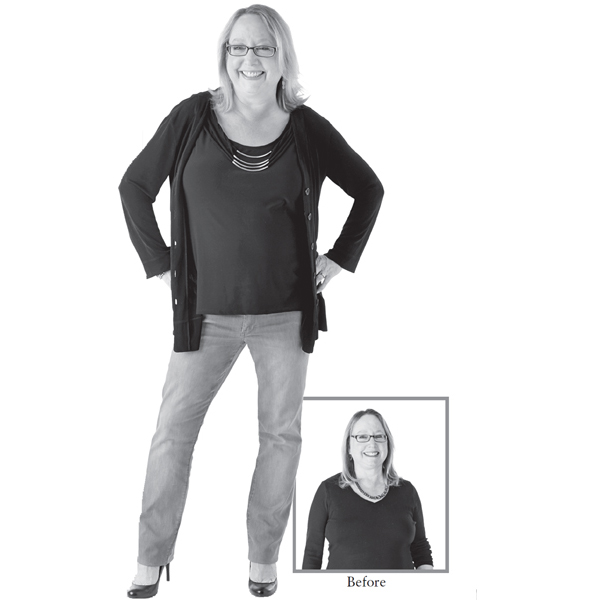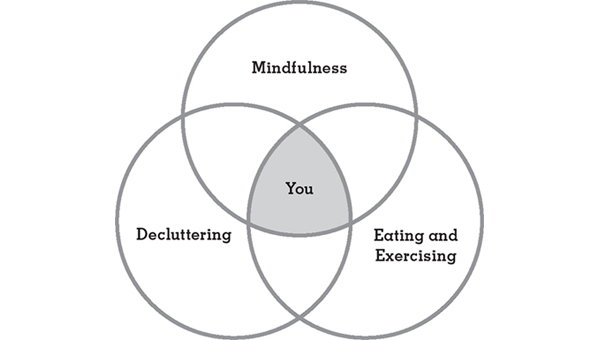Lose the Clutter, Lose the Weight (21 page)
Read Lose the Clutter, Lose the Weight Online
Authors: Peter Walsh

Say good-bye to the negative.
I'll be encouraging you many, many times over the next 6 weeks to get rid of things in your home that tell you “You failed.” I want you to clear out clothes that are too small, so that every time you open your closet they're not reminding you that you didn't succeed at losing weight those previous times. I want you to empty your garage of stuff that didn't sell at the last yard sale. I want you to get rid of purchases hiding unopened in the back of a cabinet because you felt guilty about buying them.
In Week 3 of the program, I'll offer a quick exercise that Dr. Neff recommends for improving your self-compassion. In the meantime, keep in mind the three components she suggests for how to speak to yourself in a kinder, more encouraging way.
1. Apply your mindfulness.
“A lot of people aren't even aware of the constant barrage of self-criticism they give themselves, they're so used to the voice,” she says. Pay attention (in other words, be mindful) when you're using a nasty tone of voice with yourself. In this instance, you don't need to just accept it. Instead, change your tone. “You might say that compassion is how you respond when you're mindfully aware of your own pain,” she says.
2. Be kinder.
If you catch yourself being overly critical, shift to a more caring and supportive tone. Talk to yourself as kindly as you would a friend or a small child.
3. Remember that no one's perfect and that everyone else in this world is falling short, too.
“Often when people see something about themselves they don't like, they think something has gone wrong. If all of these
other
people have normal happy lives, then it's
me
who's failed, it's
me
who's overweight,” Dr. Neff says. “Remembering that human experience is supposed to be imperfect helps reduce those feelings of isolation that can come from feeling inadequate.”
Looking Ahead
I can't stress enough that when you look at your cluttered home or your weight:
It's not about your stuff . . . and it's not about your fat
. The clutter filling your home got there because of factors related to your emotions, your mood, and your point of view. I feel confident in saying that if you're overweight, those pounds accumulated for many of the same sorts of reasons.
So remember what you've learned about the contribution your mind has made to your weight and your clutter. Coming up, I'll give you the keys to a very practical program that will help you harness your body and your mind to work together to solve these problems.
Now that you know how to
think
, it's time to start
doing
!
The Clutter Chronicles
Margie Cherry, 59
POUNDS LOST: 7.6
AMOUNT OF CLUTTER REMOVED: At least 10 bags to Goodwill, plus countless bags of trash

Visitors to Margie's home tell her that it feels “homey, warm, and inviting,” she says. However, she sensed a general atmosphere of disorder throughout the home. Though she regarded much of it as “creative clutter” that she generated while working as a comedian, cartoonist, and life coach, “It became too much for me,” she says.
“When you have clutter in your home for so long, it blends into the background like wallpaper,” Margie explains. “You don't recognize it's there, or you have a subconscious sense that it
belongs
there.”
During the program, Margie learned to see her surroundings through new eyes, even though she struggled with the mindfulness exercises. (“I have
shpilkes
âthe Yiddish word for people who are
restless and can't sit still!”) With her new awareness, though, she noticed a bread machine that was taking up valuable kitchen counter space (and collecting clutter on its flat surface). Her husband had bought it 10 years ago, and though he frequently used it at first, it soon fell into disuse. As Margie looked at the machine, she realized it was malignant clutter. “What is this thing doing on my counter?” she asked herself. “I don't use it, and I don't need it.” She moved it to the basement and laughingly notes that it was like “excising a tumor.”
Her bathroom scales may deserve a trip to the trash bin, as they weren't very accurate in helping her stay aware of the present moment. “My scales showed that I'd lost like
1 pound
. When you think you're working hard and not getting anywhere, it's frustrating,” she says.
When she checked in for her follow-up photo at the end of the program, she had a pleasant surprise. She'd actually lost more than a pound
per week
, as well as 4½ inches from her waist. And that success unleashed her inner Christie Brinkley
. “
As soon as that camera started clicking, I found myself striking sassy poses that I didn't know I had in me!” she exclaims. “Could it have been the 5-inch heels, the skinny jeans, or the discovery that, despite fearing I had failed at my diet plan, I actually lost over 7 pounds and multiple inches?”
Along with her improved sassiness, Margie says she's better able to see her surroundings as they really areâand she's willing to make any fixes that are necessary. And she's applying these skills to other parts of her life. “I'm able to look at things that my eyes glossed over before. The lens through which I was viewing shifted. I can take control over things I didn't think I had control over before. I know I can slowly but surely chip away at things like my weight,” she explains. “The main change is that I feel empowered. Just knowing you have power can change the way you do everything for the rest of your life.”
Part 2
The Lose the Clutter, Lose the Weight Blueprint
Chapter 5
HOW THE PROGRAM WORKS
S
ix weeks isn't very long, but if you have determination and a good plan, even this brief period can become a momentous turning point in your life. In just a month and a half, it's possible to turn an unmanageable maze of a home into a well-organized refuge
while
you're melting away stubborn pounds
while at the same time
you're shaking loose upsetting emotions and deeply ingrained ways of looking at yourself.
If you're skeptical that you can accomplish all this at the same time, I understand. Simply trying to keep your home clean at a surface level can be exhausting. If just straightening up the mess you've made over the past few days takes so much effort, how can you possibly sort and haul out years (or decades) of accumulated stuff that has packed the deepest nooks and crannies of your home?
Add to that the challenge of losing weight, which may feel even more difficult than decluttering your home. The work that goes into weight loss can be time-consuming and frustrating. If your approach requires counting calories, carbs, or grams of fat, it adds a substantial chore to your day. If you're steeply cutting back on the amount of food you allow yourself, or forcing yourself to eat unappealing foods, these changes also make each day a new exercise in unpleasantness.
Also, few people make one weight loss attempt, then cruise through the rest of their lives at their ideal weight. If you're currently overweight, odds are good that you remember your history of unsuccessful attempts whenever you're trying to launch a new effort. You likely have a “Greatest Weight Loss Failures” video that's ready to play at any time in your head.
This brings us to the challenge of taming your
mind
at the same time as your
body and your home. Your mental processes can be even more stubborn than your weight or your home's organization. Some people who seek therapy to shake their anxiety or depression learn in a dozen or fewer sessions how to use tools to change their behaviors and thoughts. But some stay in therapy for years.
Even given all these challenges, do I
really
believe it's possible for a normal human being to make a lasting improvement in all three of these areas in a short period of time? I truly do. You're holding the directions in your hands, and I've seen people do wonderful things with this plan. That doesn't mean it's easy. Starting the program is a bit like getting a treadmill. Just setting the treadmill in your home (and in many homes, that's
all
the treadmill is doing) won't change your weight. You have to get on it and start walking.
As you start this program, you're going to have to apply a positive attitude, a lot of focus, and some serious commitment. You'll have to power through some challenging moments.
You can do this. I've seen people accomplish these achievements many times, and I know it's possible.
During the next 6 weeks, while you focus on your home, body, and mind, try to keep yourself firmly aimed at the intersection of the three circles in this diagram, so the same effort moves you toward all three goals.

Plenty of people have told me that they've cleaned out their homes, come to feel better about themselves, and watched their clothing size shrink all at one time. Often, they were only focusing on decluttering their home, and the other improvements just sort of happened without any additional work.
But when I was putting together this program, I wanted
proof
that it
works, both for myself and for my readers. I wanted to carefully observe which elements were especially helpful and which needed adjustment before I made the program available to the public. I wanted to make sure it provided the right advice and motivation. That's why I assembled the test panel to blaze the trail for you.
Putting the Program to the Test: Meet Our Brave Test Panelists
My editors and I put out a notice in traditional and social media seeking participants who wanted to improve their health and their home environment at the same time. A lot of people must have been feeling trapped under the weight of their homes (and their bellies and thighs), because we received a flood of interest.
Once we assembled the test panel of participants, we saw that many of them had a good reason to want to make these changes. I met with all of them to share the details of the program (as you'll find in
Chapters 9 through 14
). In return, they opened up and shared a lot of their secrets. They filled out a survey to gauge their anxiety level and another questionnaire to measure their attitudes toward clutter (just like you did in
Chapter 3
, although you got to keep your results private). They brought me pictures of the interiors of their homes. They allowed a nurse to weigh them and measure their hips and thighs. They rated their self-esteem. Given this level of commitment and openness, you can understand my admiration for them and why I call them brave!
The panelists came in all sorts of body sizes, but most were overweight based on their body mass index, which made them average representatives of today's society. Their average BMI was 32, officially categorized as obese. Overall, their self-esteem and energy levels weren't great. As a group, their relationship with clutter was having a substantially negative impact on their emotions and their quality of life.
